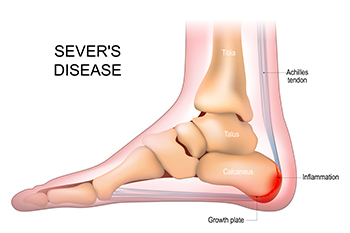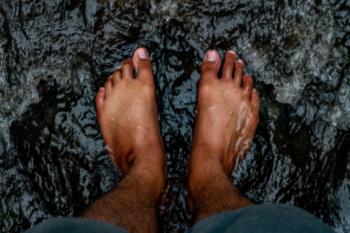Items filtered by date: October 2025
Symptoms and Risk Factors for Sever’s Disease

Sever’s disease is a common cause of heel pain in growing children and adolescents. It occurs when the growth plate in the heel becomes inflamed due to repetitive stress, often from running or jumping. Risk factors include rapid growth, tight calf muscles, and participation in high-impact sports. Symptoms include heel pain, swelling, and discomfort during physical activity. A podiatrist can diagnose Sever’s disease, recommend rest, stretching exercises, supportive footwear, and custom orthotics to relieve pain and prevent recurrence. If your child complains of heel pain or limps after activity, it is suggested that you schedule an appointment with a podiatrist for accurate evaluation and appropriate treatment.
Sever's disease often occurs in children and teens. If your child is experiencing foot or ankle pain, see one of our podiatrists from Chicago Foot Specialists. Our practitioners can treat your child’s foot and ankle needs.
Sever’s Disease
Sever’s disease is also known as calcaneal apophysitis, which is a medical condition that causes heel pain I none or both feet. The disease is known to affect children between the ages of 8 and 14.
Sever’s disease occurs when part of the child’s heel known as the growth plate (calcaneal epiphysis) is attached to the Achilles tendon. This area can suffer injury when the muscles and tendons of the growing foot do not keep pace with bone growth. Therefore, the constant pain which one experiences at the back of the heel will make the child unable to put any weight on the heel. The child is then forced to walk on their toes.
Symptoms
Acute pain – Pain associated with Sever’s disease is usually felt in the heel when the child engages in physical activity such as walking, jumping and or running.
Highly active – Children who are very active are among the most susceptible in experiencing Sever’s disease, because of the stress and tension placed on their feet.
If you have any questions, please feel free to contact our office located in Chicago, IL . We offer the newest diagnostic and treatment technologies for all your foot care needs.
Wearing the Right Shoes for Standing Jobs

For those who work on their feet all day, wearing the right shoes is essential for comfort, safety, and overall health. Proper footwear offers stability and cushioning while providing the only interaction between your body and the ground. Shoes with safety features, such as slip-resistant soles and arch support, help prevent injuries and fatigue. Wearing the wrong shoes can lead to foot problems like plantar fasciitis, calluses, and lower back pain. A podiatrist can evaluate your feet, recommend supportive footwear, and provide custom orthotics for added relief. If you have developed foot pain during your work day, it is suggested that you consult a podiatrist who can treat various foot conditions and guide you on the proper shoes to wear for optimum foot health.
While working on the feet, it is important to take the proper care of them. For more information about working on your feet, contact one of our podiatrists from Chicago Foot Specialists. Our practitioners will treat your foot and ankle needs.
Working on Your Feet
Standing on your feet for long periods of time can cause stress and pain in your feet. Your whole body may experience change in terms of posture, back pain, bunions, callouses and or plantar warts. There are ways to avoid these conditions with proper foot care, smart choices and correct posture.
Positive Changes
Negative heeled shoe – Choosing this shoe type places the heel slightly lower than the ball of the foot. These are great for overall foot health. Find shoes that fit you correctly.
Go barefoot – Our feet were not designed to be enclosed for all hours of the day. Try to periodically expose your feet to air.
Eliminate Pain
Foot Exercises – Performing simple exercises, incorporating yoga and doing stretches are beneficial. This will allow increased blood flow to the area and muscles of the foot.
Achilles tendon – Stretching the foot out flat on the floor will relax the calf muscles and tendon. These exercises can be performed almost anywhere. Make sure you add these exercises to your daily regimen.
With a little bit of this information and knowing more about foot health, you will notice changes. Foot stretches and proper footwear will help with pain and prevent further issues.
If you have any questions please contact our office located in Chicago, IL . We offer the newest diagnostic and treatment technologies for all your foot and ankle needs.
Treat Your Feet to a Medical Pedicure
Freiberg Infraction and Foot Pain

Freiberg infraction is a condition that affects the long bones in the front of the foot, most often the second metatarsal. It happens when the bone under the toe joint loses its normal blood supply, leading to tiny fractures and collapse of the bone surface. This can cause pain in the ball of the foot, swelling, and stiffness in the toe. Walking or wearing tight shoes may make the discomfort worse, and over time, the joint may become stiff or uneven. The condition is more common in teenagers and young adults, especially those who are active in sports, although adults can develop it, as well. Treatment may involve rest, wearing cushioned shoes, orthotics, or targeted exercises to relieve pressure and improve movement. Severe cases may require surgery. If you have persistent pain in the ball of your foot, it is suggested that you see a podiatrist for evaluation and appropriate treatment.
Some foot conditions may require additional professional care. If you have any concerns, contact one of our podiatrists of Chicago Foot Specialists. Our practitioners can provide the care you need to keep you pain-free and on your feet.
Rare Foot Conditions
The majority of foot conditions are common and can be treated by a podiatrist. Standard diagnostic procedures are generally used to identify specific conditions and treatment can be rendered. A podiatrist also treats rare foot conditions which can be difficult to diagnose and may need extra attention and care.
There are many rare foot conditions that can affect children. Some of these can include:
- Freiberg’s disease
- Kohler’s disease
- Maffucci syndrome
Freiberg’s disease - This can be seen as a deterioration and flattening of a metatarsal bone that exists in the ball of the foot. It typically affects pre-teen and teenage girls, but can affect anyone at any age. Symptoms that can accompany this can be swelling, stiffness, and the patient may limp.
Kohler’s disease - This often targets the bone in the arch of the foot and affects younger boys. It can lead to an interruption of the blood supply which ultimately can lead to bone deterioration. The patient may limp or experience tenderness, swelling, and redness.
Maffucci syndrome - This affects the long bones in a child’s foot leading to the development of abnormal bone lesions. They are benign growths and typically develop in early childhood and the bones may be susceptible to breaking.
A podiatrist can properly diagnose and treat all types of rare foot conditions. If your child is affected by any of these symptoms or conditions, please don’t hesitate to call our office so the correct treatment method can begin.
If you have any questions, please feel free to contact our office located in Chicago, IL . We offer the newest diagnostic and treatment technologies for all your foot care needs.
Living With a Hammertoe

A hammertoe occurs when one or more of the smaller toes bend abnormally at the middle joint, creating a curled or hammer-like appearance. This condition may start with mild stiffness, but often progresses to a rigid contraction that makes wearing shoes painful. Friction from footwear can lead to corns, calluses, and skin irritation, while the altered position of the toe can disrupt balance and gait. Causes include muscle imbalance, wearing tight footwear, genetic factors, or underlying conditions such as arthritis. Early treatment focuses on relieving pressure with choosing wider shoes, toe pads, or custom orthotics, as well as stretching exercises to improve flexibility. More advanced cases may require surgical correction to restore proper alignment. Addressing a hammertoe promptly can prevent progressive damage and chronic discomfort. If you are experiencing pain or difficulty caused by a hammertoe deformity, it is suggested that you visit a podiatrist for evaluation and appropriate treatment.
Hammertoe
Hammertoes can be a painful condition to live with. For more information, contact one of our podiatrists from Chicago Foot Specialists. Our practitioners will answer any of your foot- and ankle-related questions.
Hammertoe is a foot deformity that affects the joints of the second, third, fourth, or fifth toes of your feet. It is a painful foot condition in which these toes curl and arch up, which can often lead to pain when wearing footwear.
Symptoms
- Pain in the affected toes
- Development of corns or calluses due to friction
- Inflammation
- Redness
- Contracture of the toes
Causes
Genetics – People who are genetically predisposed to hammertoe are often more susceptible
Arthritis – Because arthritis affects the joints in your toes, further deformities stemming from arthritis can occur
Trauma – Direct trauma to the toes could potentially lead to hammertoe
Ill-fitting shoes – Undue pressure on the front of the toes from ill-fitting shoes can potentially lead to the development of hammertoe
Treatment
Orthotics – Custom made inserts can be used to help relieve pressure placed on the toes and therefore relieve some of the pain associated with it
Medications – Oral medications such as anti-inflammatories or NSAIDs could be used to treat the pain and inflammation hammertoes causes. Injections of corticosteroids are also sometimes used
Surgery – In more severe cases where the hammertoes have become more rigid, foot surgery is a potential option
If you have any questions, please feel free to contact our office located in Chicago, IL . We offer the newest diagnostic and treatment technologies for all your foot care needs.


